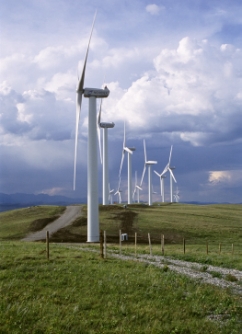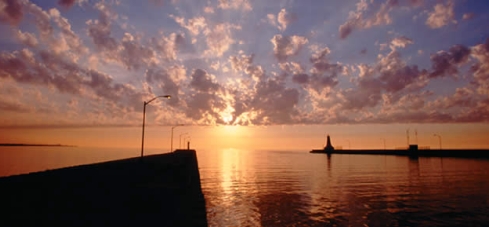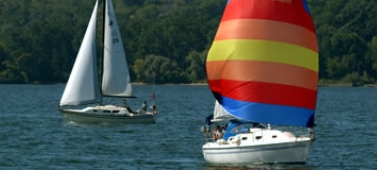I can't think of a better storyline than to have Hamilton proclaimed as Canada's Greenest City someday.
By Jason Leach
Published February 19, 2005
Why should you care?
I don't think that any of us are thrilled and excited to have four-day smog warnings in the middle of February. Nor should we be too excited by the fact that Hamilton set an all-time smog reading in Ontario last fall.
Humans nature is selfish and shortsighted. For example, I'm willing to bet that if I stopped ten Hamiltonians on the street and asked them if they thought it was fair that Dofasco was forced to stop dumping in the harbour a few decades ago and has since spent billions of dollars upgrading their plants to become more environmentally friendly, probably nine would say, "you betcha!"
Yet many of those same people would balk at the suggestion that they should minimize car use and take transit, or that tax money should fund a major investment into our transit system to make it a viable option. We citizens can do several things to give our city a greener future, but as typical humans we are always quick to point the finger at everyone else. Why should Dofasco and Stelco not be allowed to dump in our harbour when you and I do every day?
Why should these industries be forced to follow strict guidelines regarding the levels of pollution that spew from their smokestacks when you and I are allowed to sit idling in drive-thru banks, coffee shops and fast food chains? Cars, in case you didn't know, are the largest contributors to nitrogen oxide emissions and significant contributors to other air pollutants.
In a recent report released by Clean Air Hamilton, they mention the gains that have been made by local industry in recent years and actually stated that future gains in reducing pollution will now have to come from local citizens and city council making proper choices about development and transportation issues.
Only time will tell, but there are several local initiatives that are beginning to make a difference and are kick-starting the process of bringing sustainable, healthy urban development to Hamilton. Let's take a quick look at some of them.
Positive Power Co-Op is in the process of bringing wind power to Hamilton. They have concluded their first round of wind research and are hoping to construct Hamilton's first wind turbine at the Hamilton Drumlin in Flamborough by the end of 2005. Initial research is now underway on Positive Power's second project - a multi-turbine wind farm on the shores of Lake Erie in Haldimand County. They hope to begin construction on this project at the end of 2006 or early in 2007.
Our area is blessed with many geographic features that make wind-powered electricity generation a viable possibility. It would be wonderful to see one or more wind turbines along Hamilton Harbour's industrial shoreline or the Lake Ontario shore. Not only is wind power a clean, environmentally friendly source of electricity, but the mere sight of these massive turbines in and around our city would go a long way towards improving our image and putting us one step closer to becoming a green city.

Photo Credit: http://www.nordex-online.com
Green Venture is located in an 'ecohouse' at 22 Veevers Dr in Hamilton. The house has been retrofitted as a local example to homeowners of the many ways in which energy can be saved and used more wisely in our everyday lives. Their website has an abundance of great info on wise water use, backyard composting, a tree-planting program, pesticide-free lawns and gardens, and Hamilton's Commuter Challenge which is an annual competition aimed at getting residents to find another way to get to work for one week other than their car. Many Hamiltonians take part in this event and use such modes of transportation as rollerblading, cycling, walking, transit and even canoeing across the harbour!
Transportation for Liveable Communities is based out of McMaster University and promotes sustainable modes of transportation to local residents and to city hall. They hold monthly Critical Mass bike rides through the streets of Hamilton as well as an annual Car Free Day celebration in conjunction with world-wide Car Free Week.
Bay Area Restoration Council has long been an active leader in the cleanup of Hamilton Harbour and Cootes Paradise. They host regular harbour shoreline cleanups and publish a quarterly newsletter outlining the various activities and progress being made at our harbour.

Photo Credit: http://www.hamiltonhabour.ca
The Sky Dragon Centre is in the planning and development stages of constructing an eco-building in downtown Hamilton that will house affordable apartment units, classrooms, an organic café and market, an art gallery and community space. The long-term plan is to incorporate a rooftop garden along with wind, solar and water power to the building which is sure to become a downtown landmark and model for other building owners to follow.
Hamilton Port Authority is currently working on a plan to take trucks off of the QEW and transport them by ship from a port in Oswego, New York to Hamilton's Port. The initiative is a part of the marine transportation strategy for the great lakes called Highway H2O.
The Port is also developing a master plan for the redevelopment of the Fisherman's Pier area underneath the Skyway bridge. The plan calls for a new marina as well as shops, restaurants and enhanced pedestrian space along the waterfront. They are aiming to make this a sustainable development with green building principles in the design.
Vision 2020 was first developed in 1993 to help guide growth and development in Hamilton. This seminal planning document has recently been revived and is being incorporated into the city's new Official Plan. Vision 2020 calls for more compact urban development, less car-dependent sprawl, more greenspace, cycling infrastructure and transit use in an effort to help Hamilton cut down on air pollution and make better use of our land.

Photo Credit: htttp:// http://www.hamiltonport.ca
Environment Hamilton was born out of a small group of Hamilton residents who were concerned about work being done on the old Rennie Street landfill site.
EH was incorporated as a non-profit organization in 2001 and has implemented many excellent environmental initiatives such as the Trees Count program, which examines all the trees in certain city neighbourhoods and then brings recommendations to the local residents and city council on how best to maintain the health of area trees and where new plantings are needed. This program has been very well received and will continue in the spring of 2005.
Stack Watch is another EH program which educates residents on how to identify harmful emissions coming from the smokestacks in our industrial district. There is contact info to the Ministry of the Environment so that concerned Hamiltonians (which we should all be) can take the proper steps to report emissions that are harmful to our air and illegal according to Ministry standards. Other EH projects include People Powered Planning, Transit for Hamilton Neighbourhoods and Student Stream Stewards.
The City of Hamilton's Street Tree Planting Program was reinstated last year and is now accepting applications from local residents and businesses for planting to take place in 2005. Much hard work and lobbying was done by many local residents during recent years to see this program return to city hall and the hope is to see funding for this program and for ongoing tree maintenance increase in future years.
Kudos to city hall for bringing back the tree planting program. Now, it's up to you and me to order the species of choice and do our part to help make Hamilton green!
Macgreen is based out of McMaster University and is a great source of info regarding alternative transportation choices, waste reduction, energy conservation as well as several special events to educate local residents and students about what we can do to make better use of our resources.
Finally, Hamilton Community Energy is a project undertaken by Hamilton Utilities Corporation. This district heating plant located at Sir John A. MacDonald Secondary School produces both heat and electricity in a much more energy efficient manner than a typical gas-fired boiler. The energy plant supplies heat to a large number of downtown buildings including City Hall, Copps Coliseum and the Hamilton-Wentworth District School Board, the Market/Library, Hamilton Place, the Convention Centre, The Board of Education, Art Gallery, The Ellen Fairclough Building, and Sir John A. MacDonald High School.
The district energy plant reduces emissions of greenhouse gases downtown and helps to create a cleaner environment. Hamilton Community Energy hopes to construct similar projects in the future in an effort to provide clean and cheap energy to local companies while simultaneously improving our air quality.
Hamilton has been known as Steeltown for several decades. We are proud of our industrial past and the resulting wealth that has been brought into our city because of it.
But, without a doubt, something is changing. We are cleaning up our waterways, and improving our air quality. I can't think of a better storyline than to have Hamilton proclaimed as Canada's Greenest City someday. From smokestacks and car fumes to windmills and light rail lines. Let's all do our part to give Hamilton a green and healthy future!

Photo Credit: http://www.conservationhamilton.ca
By MHornell (registered) | Posted None at
I just discovered RTH through the link to the Kunstler article on Planetizen. Superb site; I wish we had something similar in Victoria. Can Hamilton become a green city? Absolutely. I was the Coordinator for the Regional Chairman's task force on sustainable development back in the early 90's and served as scribe to the task force in writing Vision 2020. As you point out in this article, the vision is still relevant, and I find it heartening to see that council has reconfirmed it. The rewards in planning are often long in coming, and looking back I'm somewhat amazed to consider the extent to which we were pioneers in local sustainability in those days, and that Chairman Reg Whynott's interest in finding an organizing framework for regional revitalization, meshed with the passion for SD of a young Strategic Planning staff under the leadership of John Barr. It was one of those rare alignments of good policy and good politics, and the moment was seized. But as with all plans, the proof is in the action taken, and in this regard, I'm not sure if Vision 2020 has been as successful as we hoped then in re-orienting business as usual. Certainly the official site identifies an enviable track record of activity at the policy level. Great work has been done on monitoring, training, community outreach etc. But on the ground, the evidence is somewhat harder to see. Since relocating to BC in 1992, I've only been back to Hamilton once (in 2003)and I came away feeling somewhat depressed at how little had changed, and how much more remained to be done. Successes I could see: the revitalized North End waterfront; the downtown campus of McMaster University; some of the physical improvements to downtown streetscapes. On the other hand,the sprawl on the south mountain continues to consume farmland (enabled by the completion of the E/W connector)and downtown seems even more depressed than when I lived there. And as another article points out, the Red Hill Creek Expressway is, alas, still alive and kicking. Vision 2020 still forms a solid platform for action; but the action has to follow and as one of your other articles on image points out correctly, if you want to change your image, you have to change your reality, and the best reason to do that is for the people who already call Hamilton home. Make it better for yourself, and others will want to be there too. In closing I believe now as I believed then that Hamilton has huge potential: the most stunning physical setting in Ontario, magnificent natural amenities, a wonderful store of beautiful historic architecture, a rich multi-cultural community, superb educational institutions, and one of the most real, and authentic public markets in Canada. Best of all, Hamilton is a real city, with an urban tradition and self-image, situated in one of the richest region's in North America. Hamilton has also had the advantage of hard times, which long ago should have scrubbed any sense of complacency away and focused minds on the work that needs to be done. You've got the vision; now for the followthrough. Best regards in your work, Mark Hornell Director of Regional Planning, Capital Regional District, Victoria, BC
You must be logged in to comment.
There are no upcoming events right now.
Why not post one?